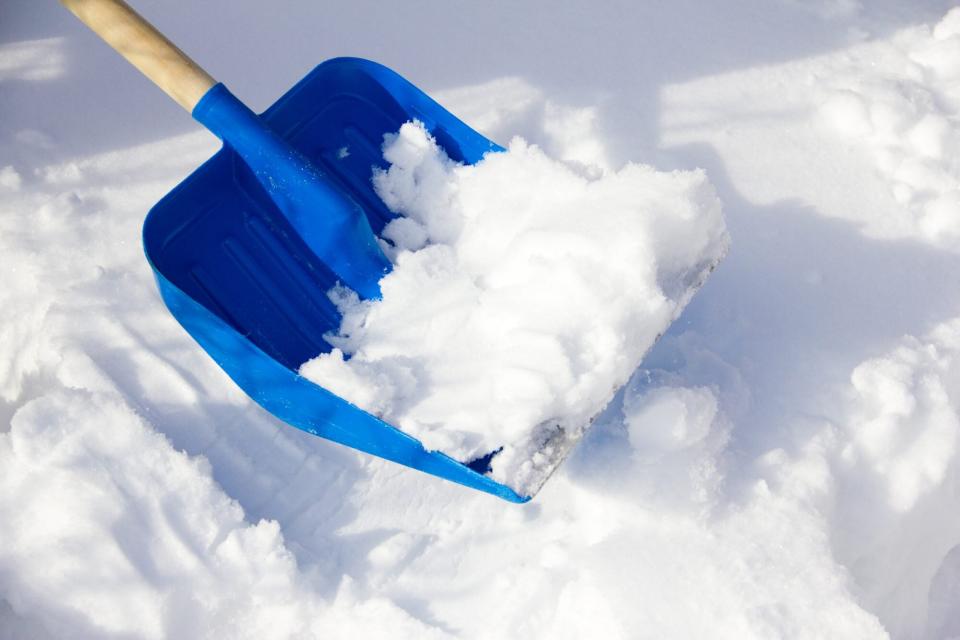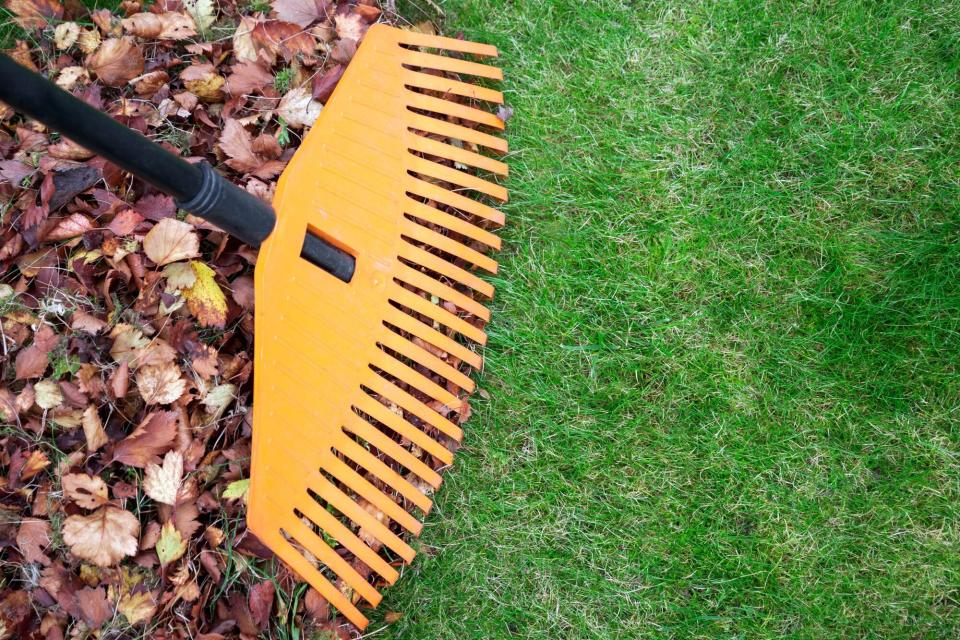Our Comprehensive Seasonal Guide to Yard Cleanup

GETTY IMAGES
TABLE OF CONTENTS
On This Page
Fall Yard Cleanup
Winter Yard Cleanup
Spring Yard Cleanup
Summer Yard Cleanup
Yards serve as a personal, private oasis, but to keep them that way—cleanup routines are essential. That means tending to their specific needs, depending on the seasons. "For those DIYing their yard, winter is a giant reset button," says Craig Elworthy, founder of Lawnbright, a DIY lawn care subscription company. "The weeds die off and your lawn goes dormant, requiring little attention until spring." This time is ideal to clean up your yard to bring it to its healthy state once the temperatures start to rise again.
Don't discount your spring cleanup, either. This period allows you to refresh your lawn and garden after the harsh, chilly conditions for a season of outdoor entertaining. To ensure your yard stays healthy year-round, follow this guide—especially before and after winter—to repair and renew it.
Related: 5 Genius Strategies That Will Make Your Lawn the Envy of the Block

Mkovalevskaya/Getty Images
Fall Yard Cleanup
"Fall yard cleanup is vital to ensure spring success in your lawn and garden beds while protecting your property's investment," says Joan Casanova of Green Earth Media Group. "Proper preparation and protection of lawns and gardens in fall will enable the yards better endurance during the low temperatures and rigors of the winter season."
Dethatch
The first rule of thumb for pre-winter yard cleanup is getting all of the leaves off of it before the season sets in. Elworthy says your lawnmower is your best tool for this practice. "Leaves are a great source of organic material, and you should mulch them back into your lawn if you can," he says. "But be careful though, if your lawn is covered in a thick blanket of leaves, you'll want to bag them and dispose of them somewhere else." The thick layer of leaves will clog up your lawn and decrease its airflow.
Related: What to Do—and What Not to Do—With Dead Leaves in the Fall
Aerate
After dethatching, it's important to break up the soil so it doesn't pool, and allow the nutrients to get into the grass before the winter. "Aeration prevents soil from becoming compacted and covered with thatch, a thick layer of roots, stems, and debris that blocks water, oxygen, and nutrients from reaching the soil," says Kris Kiser, the president and CEO of the Outdoor Power Equipment Institute's TurfMutt Foundation.
Casanova explains that a garden fork will do the job for small yards, but if you have a larger yard, you may need a walk-behind aerator, which you can rent from a hardware or home improvement store. "It's unnecessary to remove the plugs or cores from the lawn after aerating," she adds. "In a few days, these small pieces of lawn should break down and become unnoticeable. This process is aided by watering your lawn deeply after aerating or by rainfall."
Overseed
"Overseeding in fall, when the soil temperature is still warm, is a great time for germinating seed," says Casanova. "Plus, weed seeds don't germinate in the fall, and that means less competition for your new seedlings." Overseeding essentially means that you will be planting more grass seed in your yard to boost its health (think: fill up those dead spots from the summer heat). The cooler air temperatures will limit any pest and fungus growth, and the rainy conditions can help nourish the grass. In turn, you'll be able to protect your lawn from damage. Consider overseeding with a ground cover, such a Miniclover (from $7.49, outsidepride.com), since it's drought tolerant and acts as a natural fertilizer wherever it grows.
Prune
Even though there's a general notion that you shouldn't prune in the fall and you should reserve this practice solely during spring and summer—if you see dead, diseased, or broken tree branches, prune and remove them before inclement weather strikes. "This is especially important in areas prone to heavy snow, ice, and windstorms that can cause dead branches to fall, unexpectedly and cause damages," says Casanova. "Exceptions are spring-blooming perennials like lilac or forsythia, which can be pruned without risking blooms. Summer flowering plants usually blossom on new wood, and those are the varieties that should be trimmed back in fall."
Mulch
Add mulch around plants, too, during fall. This helps prevent soil erosion and weed growth. "Be sure to give perennials and cool-weather annuals a 2- to 3-inch layer of mulch to keep them healthy during the winter," says Casanova. "Applying mulch in the fall can also greatly reduce weed growth, leaving you with little to none to pull in the spring. Use your gloved hands and a rake to easily spread."
Mow
It's important to continue mowing your lawn before the first frost—particularly at the right height. "Find the just-right length for your yard's species, typically between 2 to 3 inches, to keep the grass healthy when it turns cold," Kiser says. Cutting your grass low will allow ample sunlight to get to its crown and help the soil dry out quicker come springtime, adds Casanova.
Related: 6 Home Checks to Make After a Winter Storm

wihteorchid / Getty Images
Winter Yard Cleanup
To clean up your yard during the winter season, you will need to be mindful of the conditions. As previously mentioned, you will want to keep an eye on any dead or damaged tree limbs as a key priority. If you didn't before, this is the time to remove branches altogether, as snow and ice can make them fall.
Remove Problematic Branches
Using clippers, a chainsaw, or pole pruner, following safety precautions, Kiser recommends carefully removing any dead branches. For more problematic trees, he suggests consulting with an arborist to tend to the trees. "If snow or ice have snapped a limb, look at the cut and assess the damage," he says. "Try to get a clean cut on an already broken branch or limb, as this will make it more difficult for insects or disease to enter the stressed area on your tree or shrub."
Clear Pathways
Before a large snowfall, mark pathways to clear and beds to avoid. This way, Kiser says, when it's time to run your snow thrower, you won't accidentally cut a path through the lawn. Follow your manufacturer's safety procedures as you clear all pathways to keep your yard in its best shape.
Use Rock Salt Mindfully
Apply rock salt to trouble areas to clean up your surrounding property after a winter storm. However, this substance can also damage plants and trees because it draws water away from their roots. If you notice that you've added rock salt around your trees and shrubs, remove it. "Salt should also be cleaned off pet paws following a romp outside in the snow," adds Kiser. You can also use gypsum on the areas of the lawn where the salt connected with your lawn and plants.
Related: An Eco-Friendly Guide to Yard Waste Removal

GETTY IMAGES
Spring Yard Cleanup
Before starting your spring yard cleanup, wait until the temperatures are at least 50 degrees Fahrenheit for seven straight days. "Many types of bees and other pollinators hibernate in plant stems and leaves over winter and won't emerge until it's warm enough," says Casanova. "You don't want to disturb them or accidentally kill them by starting too early." Plus, this buffer period will allow the ground to completely dry and thaw out and prevent soil compaction.
Remove Dead Materials and Litter
"During winter, things may blow into your yard that don't belong there," says Casanova. "Once the snow melts, you'll easily see what needs to be removed, such as leaves that may have blown into your yard, pinecones, fallen tree branches, and dog waste that may have ended up on your lawn." She says to keep any leaf litter that built up in garden beds, as ground-nesting bees could be hibernating underneath and won't come out until mid-spring. Otherwise, throw away or compost other debris.
Trim Perennials and Remove Annuals
Spring is the time to cut back dead leaves and branches on your perennials and remove annuals. Use an all-purpose pruner to help spur future growth. Casanova notes that if you don't take off these dead pieces, the perennials could have trouble getting access to proper amounts of sunlight and cause growth struggles. "If there are any forgotten annuals from fall, it's time to hand-pull them up by the roots, bag, tie, and discard," she adds.
Remove Winter Mulch and Protection
"Once the temperature starts to warm up, you can hand-remove any winter mulch you may have added over your sensitive plants last fall," says Casanova. "Winter rain and snow can compact mulch and make it harder for water and air to pass through to the soil below." After getting into the mulch layer in planting beds and around trees, you can decide from there if you want to add more volume. The best practice is to have 2 to 4 inches of depth for mulch. Additionally, this is the time to remove and clean any coverage you had on your shrubs or plants, such as burlap wraps or other winter protection, that can be placed on them in the fall.
Rake
Before you mow your lawn for the first time (the experts recommend waiting until the grass is above 2 to 3 inches in height), make sure to rake your lawn thoroughly. "This will help to get airflow in the root system, and it will help your lawn 'wake up,'" says Elworthy. "It's also a good chance to get any sticks or other debris that can dull your mower blade."
If you spot leaves in your garden beds, don't worry. Leaving them there is a good rule of thumb since it can serve as another layer of mulch to combat weeds. "Plus, they also feed plants as they decompose," says Casanova. "Just be sure to brush back any thick layers of leaves that are sitting on top of your plants. If you plan to add mulch, you can just lay it right over top of the leaves but hold off on mulching until the soil dries out and the weather warms."
Pull Weeds
Spring is the best time to rid your yard of weeds, since they haven't yet had a chance to firmly root themselves. The wet ground from the winter conditions makes them easier to pull, too. "Once weeding is complete, cover the soil with a thick layer of mulch to help keep weeds from sprouting," says Casanova. "If you're ambitious, you can place a layer of flat, brown, cardboard box material atop the soil, then add mulch, which will ensure weeds have a tough time sprouting."
Patch Bare Spots
"Whether they originate from disease, damage or dog urine, bare spots are unsightly," says Casanova. To tend to them, follow these steps during the spring:
Fill the exposed patch with a high-grade topsoil.
Scatter grass seed over the area (be careful not to plant too many seeds).
Rake the patch lightly (about 5 to 10 percent of the seeds should be visible) and spread a thin layer of compost over the area.
Water the seeds daily until they are moist, not soggy.
Use a quick growing ground cover, like Miniclover, which can be a perfect match for a bare patch.
Related: Tired of Your Lawn? Animate Your Yard with Ornamental Native Grasses

Stígur Már Karlsson /Heimsmyndir via Getty Images
Summer Yard Cleanup
Once the summer arrives, cleaning up your yard will mainly consist of keeping it free of debris to ward off pests. This will also boost its overall curb appeal during this season and beyond. "How you maintain your home has a direct impact on the overall value of your home and your own personal happiness," says Casanova. "Keeping your yard and gardens in prime condition is a positive, beneficial practice that can easily enhance your days year-round, throughout all seasons."
Clean Up Clutter
Tend to any clutter, such as dirt piles and other debris, that collects in your yard, as this will discourage pests from entering your lawn, garden, and your home. "Even standing water, if not removed, could invite insect-pests, like mosquitos, to lay eggs in your yard," says Casanova, adding that they can carry dangerous disease. "Sometimes unsealed food waste could attract pests that are likely to linger and may try to find a way into your home."
Cut Your Grass
Mow your lawn regularly over the summer, making sure not to cut back more than one-third of its length with each mowing. Cutting it too short can cause stress to the grass and boost the chance of space for weeds to grow. Plus, leaving the grass longer can create a stronger root system, which will help it withstand drought periods or other stressors.
Tend to Your Garden
Caring for your garden—watering and removing any weeds—will not only keep it flourishing, but it will also create a welcoming environment that you can enjoy for the summer. "Planting your favorite flowers, building a beautiful pathway, hanging bird feeders to attract songbirds, and setting out lounge chairs or a hammock to relax amidst nature's beauty and solace can create an outdoor oasis that is inviting, calming, aesthetically pleasing and a favored place to enjoy solitude or share with friends and family," says Casanova.

